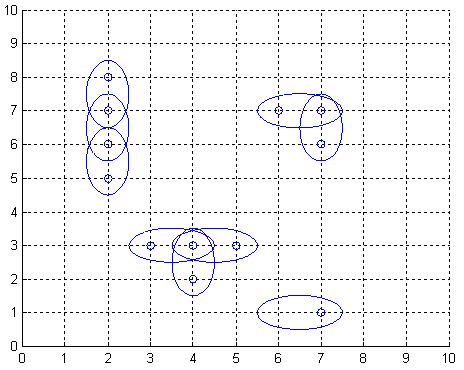poj 3020 Antenna Placement
来源:互联网 发布:cda数据分析师怎么样 编辑:程序博客网 时间:2024/06/03 14:04
Antenna Placement
Time Limit: 1000MS Memory Limit: 65536KTotal Submissions: 8561 Accepted: 4238
Description
The Global Aerial Research Centre has been allotted the task of building the fifth generation of mobile phone nets in Sweden. The most striking reason why they got the job, is their discovery of a new, highly noise resistant, antenna. It is called 4DAir, and comes in four types. Each type can only transmit and receive signals in a direction aligned with a (slightly skewed) latitudinal and longitudinal grid, because of the interacting electromagnetic field of the earth. The four types correspond to antennas operating in the directions north, west, south, and east, respectively. Below is an example picture of places of interest, depicted by twelve small rings, and nine 4DAir antennas depicted by ellipses covering them.

Obviously, it is desirable to use as few antennas as possible, but still provide coverage for each place of interest. We model the problem as follows: Let A be a rectangular matrix describing the surface of Sweden, where an entry of A either is a point of interest, which must be covered by at least one antenna, or empty space. Antennas can only be positioned at an entry in A. When an antenna is placed at row r and column c, this entry is considered covered, but also one of the neighbouring entries (c+1,r),(c,r+1),(c-1,r), or (c,r-1), is covered depending on the type chosen for this particular antenna. What is the least number of antennas for which there exists a placement in A such that all points of interest are covered?

Obviously, it is desirable to use as few antennas as possible, but still provide coverage for each place of interest. We model the problem as follows: Let A be a rectangular matrix describing the surface of Sweden, where an entry of A either is a point of interest, which must be covered by at least one antenna, or empty space. Antennas can only be positioned at an entry in A. When an antenna is placed at row r and column c, this entry is considered covered, but also one of the neighbouring entries (c+1,r),(c,r+1),(c-1,r), or (c,r-1), is covered depending on the type chosen for this particular antenna. What is the least number of antennas for which there exists a placement in A such that all points of interest are covered?
Input
On the first row of input is a single positive integer n, specifying the number of scenarios that follow. Each scenario begins with a row containing two positive integers h and w, with 1 <= h <= 40 and 0 < w <= 10. Thereafter is a matrix presented, describing the points of interest in Sweden in the form of h lines, each containing w characters from the set ['*','o']. A '*'-character symbolises a point of interest, whereas a 'o'-character represents open space.
Output
For each scenario, output the minimum number of antennas necessary to cover all '*'-entries in the scenario's matrix, on a row of its own.
Sample Input
27 9ooo**oooo**oo*ooo*o*oo**o**ooooooooo*******ooo*o*oo*oo*******oo10 1***o******
Sample Output
175
Source
Svenskt Mästerskap i Programmering/Norgesmesterskapet 2001
提示
题意:
h*w的区域有n个城市(在图中表示为*),如何使用最少的抗干扰雷达才能完全覆盖所有的城市。(覆盖方式请看图)
思路:
这题是最小路径覆盖问题,将雷达能覆盖的路径用图存起来(路径是城市与城市之间才算数),之后对图使用匈牙利算法。(详细解析)
示例程序
Source CodeProblem: 3020Code Length: 1662BMemory: 1020KTime: 16MSLanguage: GCCResult: Accepted#include <stdio.h>#include <string.h>int map[40][10],v[400],match[400],city[400][400];int dfs(int t,int n){ int i; for(i=0;n>i;i++) { if(city[t][i]==1&&v[i]==0) { v[i]=1; if(match[i]==-1||dfs(match[i],n)==1) { match[i]=t; return 1; } } } return 0;}int pro(int n){ int i,sum=0; memset(match,-1,sizeof(match)); for(i=0;n>i;i++) { memset(v,0,sizeof(v)); sum=sum+dfs(i,n); } return sum;}int main(){ int i,i1,i2,i3,h,w,t,id,a,b,x[4]={0,1,0,-1},y[4]={1,0,-1,0}; char ch[11]; scanf("%d",&t); for(i=1;t>=i;i++) { memset(map,-1,sizeof(map)); memset(city,0,sizeof(city)); scanf("%d %d",&h,&w); id=0; for(i1=0;h>i1;i1++) { scanf("%s",ch); for(i2=0;ch[i2]!='\0';i2++)//为每个城市编号 { if(ch[i2]=='*') { map[i1][i2]=id; id++; } } } for(i1=0;h>i1;i1++) { for(i2=0;w>i2;i2++) { if(map[i1][i2]!=-1) { for(i3=0;3>=i3;i3++) { a=i1+x[i3]; b=i2+y[i3]; if(a<h&&a>=0&&b<w&&b>=0&&map[a][b]!=-1)//城市之间存在通路 { city[map[i1][i2]][map[a][b]]=1; } } } } } printf("%d\n",id-pro(id)/2);//最小路径覆盖数=点数量-最小路径边数,最小路径边数=最小路径点数/2,最小路径点数=匈牙利算法 } return 0;} 0 0
- poj 3020 Antenna Placement
- Poj 3020 Antenna Placement
- Poj 3020 Antenna Placement
- poj 3020 Antenna Placement
- POJ 3020 Antenna Placement
- POJ 3020 Antenna Placement
- POJ 3020 Antenna Placement
- POJ 3020 Antenna Placement
- POJ 3020 Antenna Placement
- POJ 3020 Antenna Placement
- poj 3020 Antenna Placement
- POJ 3020 Antenna Placement
- POJ 3020 Antenna Placement
- POJ 3020Antenna Placement
- 【POJ 3020】Antenna Placement
- poj 3020 Antenna Placement
- poj-3020 Antenna Placement
- POJ 3020 Antenna Placement
- 浅拷贝和深拷贝
- Poj 2112 Optimal Milking【Floyd+二分+最大流Dinic】
- 如何检测网站的活跃用户与流失用户
- 数据库的隔离级别
- 视频 帧加密=真加密
- poj 3020 Antenna Placement
- 生命周期和画面跳转
- 今天是个重要的日子
- 最短路径
- 【整理】DOM(未完)
- Button的透明度调整
- Android:控件WebView显示网页
- source insight 编程风格(持续更新)
- 华为OJ 挑7


